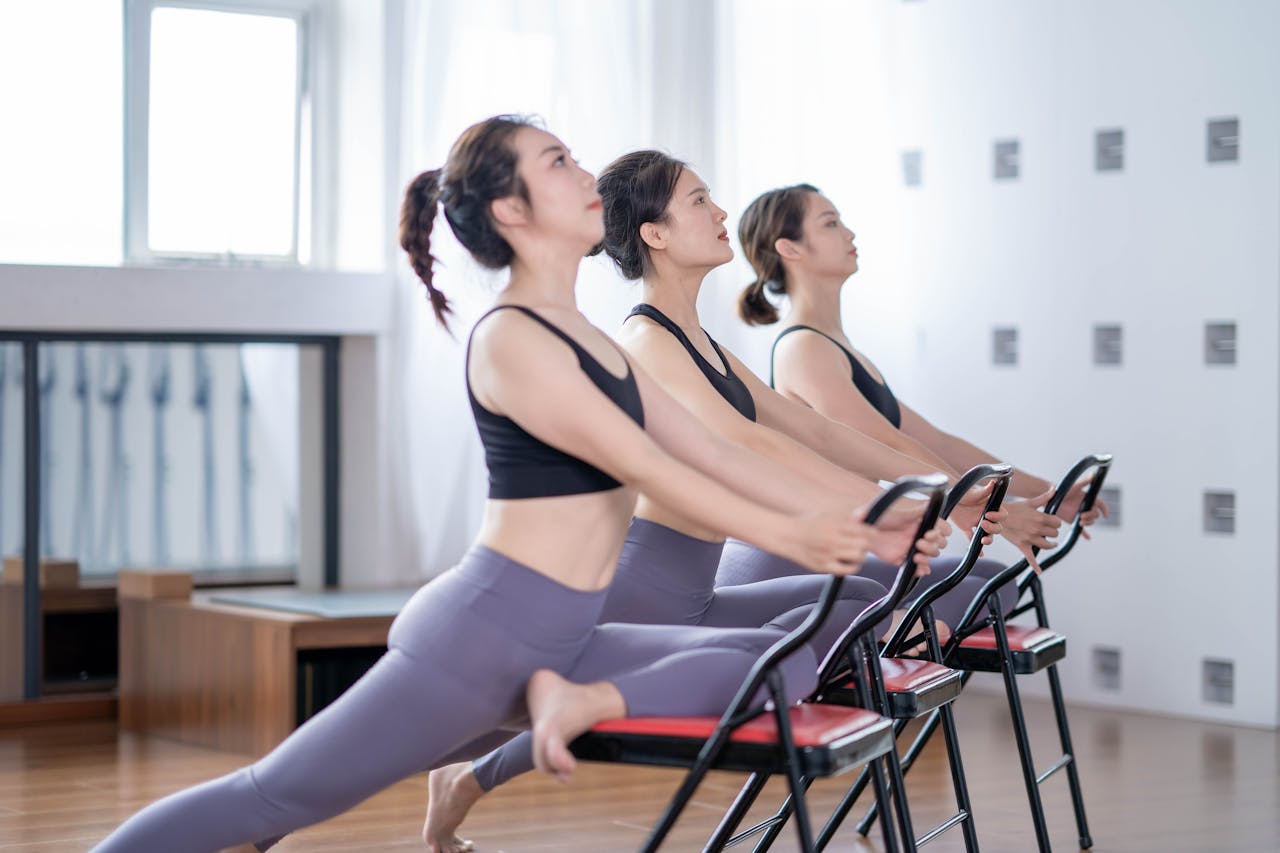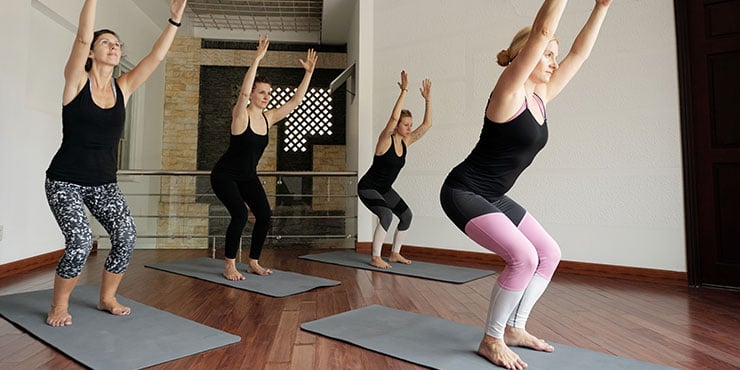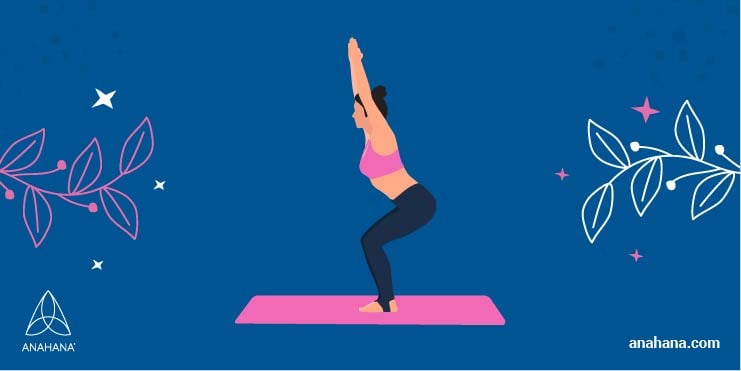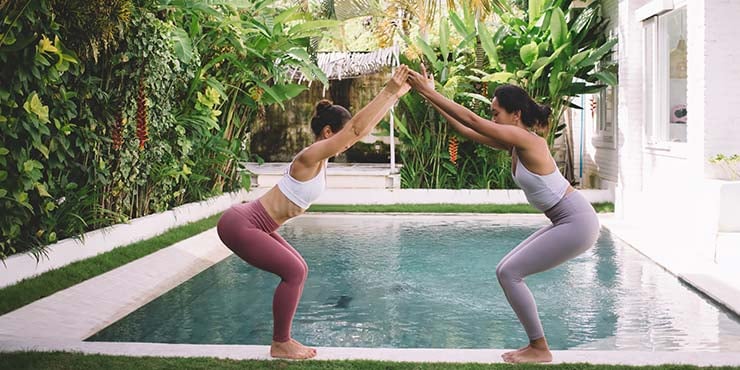
Table of Contents
Utkatasana, also known as the Chair Pose, is a standing yoga posture that strengthens the legs and generates heat in the body. This pose is commonly used in various styles of yoga practices.
Utkatasana Yoga Pose
 Utkatasana is a standing yoga posture performed with the knees bent and straight arms extended above the head with palms facing each other or together. It is also called thunderbolt pose, fierce pose, awkward pose, and powerful pose. Utkatasana gets its name from the Sanskrit words utkat, meaning intense or powerful, and asana, meaning pose.
Utkatasana is a standing yoga posture performed with the knees bent and straight arms extended above the head with palms facing each other or together. It is also called thunderbolt pose, fierce pose, awkward pose, and powerful pose. Utkatasana gets its name from the Sanskrit words utkat, meaning intense or powerful, and asana, meaning pose.
It resembles a squat, with the knees deeply bent at a 90-degree angle. This powerful pose is a part of Ashtanga yoga's primary series as both the starting and ending position of the Sun Salutation B in the Ashtanga style yoga sequence and towards the end of the standing series of yoga poses. Hatha yoga practice also incorporates the Utkatasana to strengthen the legs and generate heat due to the leg-strengthening process.
The Benefits of Utkatasana
Utkatasana, or the Chair Pose, offers numerous benefits for the whole body. Some of these benefits include:
- Strengthens the leg muscles and, more particularly, the thighs
- Improves posture by promoting alignment of the spine and shoulders
- Stimulates the heart and diaphragm, increasing cardiovascular endurance and lung capacity
- Increases circulation and balance, promoting better overall stability and control in the body
- Utkatasana is a great pose to help activate and balance the Manipura chakra, increasing feelings of empowerment and self-assurance.
- Tones the digestive organs, abdominal muscles, and heart
- Tones the buttocks, helping to shape and define the glute muscles
- Reduces stress and anxiety by calming the mind and releasing tension
- Stretches the chest, shoulders, and spine, improving flexibility and range of motion.
- Chair pose improves breathing by opening the chest and improving lung and core strength
- It builds endurance and stamina while toning the nervous system.
Contraindications for utkatasana
Utkatasana, also called Awkward Chair Pose, may not be suitable for some individuals and may need to be omitted under certain circumstances. It is not for individuals who have recently experienced injuries to the foot or hip or those with chronic knee pain.
This pose in yoga places stress on the lower back, making it inadvisable for individuals with lower back issues. Individuals with shoulder problems should avoid extending their arms overhead while practicing Utkatasana, as the full pose involves reaching the arms overhead.
Step-by-step Instructions for Chair Pose
To perform the chair pose, follow these step-by-step instructions:
- Begin standing tall with the feet hip-distance apart and parallel to each other.
- Inhale and raise the arms overhead with palms facing each other, or bring the palms together.
- Exhale and bend the knees as if one is sitting down in an imaginary chair. Keep the thighs parallel and the knees pointing in the same direction as the toes. The knees will project out slightly over the feet and the torso will form approximately a right angle over your thighs.
- Keep the chest lifted and the tailbone pointing to the floor to engage the core muscles to protect the lower back.
- Gaze forward or slightly upward while engaging the upper back muscles and hold the pose for several breaths.
- To come out of this pose, straighten the knees with an inhalation, lifting strongly through the arms.
Variations of the Foot Position in Utkatasana (Chair Pose)
The Utkatasana can be initiated from the Mountain Pose, whereby the individual bends their knees and elevates their arms overhead. Keep the feet together or hip-width apart, and inhale the arms forward parallel to the floor with the palms facing down.
Typically, the feet are kept together in the Mountain Pose, which applies to the chair pose. Still, those who experience difficulty can modify the pose by placing the feet wider apart. Alternatively, if touching the hands together is challenging, separating the arms while keeping the elbows straight could be an alternative.
Various foot position variations can also be incorporated into practicing Utkatasana, including turning the feet outwards to varying degrees. Incorporating different foot positions, such as hip or shoulder width apart or turning the feet outwards or inwards to varying degrees, may benefit individuals who regularly practice this pose with the feet together. This advice is especially relevant for beginners.
Proper Alignment in Chair Pose
 Shin Rotation
Shin Rotation
When performing standing poses like Utkatasana, proper shin rotation is crucial to maintain the position and posture of the inner arches in relation to the feet. Outward rotation of the shins may lift the inner arches, while inward rotation can flatten and sink them down. The impact of shin rotation can be observed in a chair pose with feet together or apart.
Accommodating inward rotation may require adjusting the turn-out of the feet. Proper shin rotation enhances the stability of the ankles and feet, providing a stable foundation for the muscles surrounding the knee joints and reducing knee pain or injury risk.
Weight Distribution
Proper weight distribution is essential to maintain balance and stability when performing standing poses. In poses like Chair Pose, Uttanasana, and Mountain Pose, adjusting the weight distribution can prevent discomfort and injury. When the weight is shifted backward, more pressure is placed on the heels, causing the forefeet to lift.
Leaning forward, on the other hand, puts more weight on the forefeet, potentially requiring the toes to press firmly down to maintain balance. Shifting weight forward activates the muscles in the forefeet and toes, stabilizing the feet and ankles. The weight can shift until the forefeet press down. Adjustments such as rotating the shins inward or outward can also increase comfort.
Toe Activation
When performing Utkatasana, practitioners should shift the weight slightly forward while lifting the toes to activate them. To engage the muscles on both sides of the big toes and enhance the stability of the feet, ankles, and lower leg bones, one should extend the sensation of length in the toes and spread them apart. The toes can be activated by either adjusting shin rotation first or activating the toes first.
Modifying Front-to-Back Hip and Knee Position
In the chair pose, practitioners have the option to adjust the position of their hips and knees in relation to their feet. Shifting the hips and knees towards the back causes the upper body to lean forward, while moving them forward results in a more upright posture.
When the torso is upright, the knees may extend beyond the front of the toes, while leaning forward can bring the front of the knees closer to the toes and move the shins toward a more vertical position. If reaching the hips back proves difficult, extending the arms forward instead of upwards can be helpful.
Regardless of the chosen position, it is important to consider adjustments to toe activation, forefoot activation, and shin rotation to prevent knee discomfort. If knee pain arises during the chair pose, modifying foot usage or adjusting the position of the hips relative to the feet may provide relief. If the pose cannot be executed without pain, it may be necessary to omit it from the practice.
Improving Balance in Chair Pose
When practicing Chair Pose, or Utkatasana, improving balance can be a valuable goal. In the traditional version, the feet are together, creating a challenge for balance. However, for those focusing on other aspects of the pose, the feet can be placed hip-width apart to reduce the focus on balance.
To improve left-right balance during the Chair Pose, adjusting the lateral position of the hips relative to the feet can be helpful. By moving the hips slightly to the left and right, practitioners can observe changes in weight distribution in the feet and sensations in the ankles, knees, hips, and spine. The goal is to find a position where sensations are evenly distributed in both legs.
Rotating the hips to the left and right is another method of improving balance during the Chair Pose. Practitioners should shift the hips in a way that maintains balance with the earth and distributes weight evenly between both feet. This can be achieved by repeating the movement and observing the change in pressure in each foot until the position of even distribution is found.
Practitioners should work towards better balance throughout the entire body by making adjustments from the ground up. If knee pain occurs during the Chair Pose, adjusting the position of the feet or hips, or excluding the pose from the practice, is recommended.
Engaging the Hip Muscles in Utkatasana
 When performing Utkatasana, activating the hip muscles can be achieved by rotating the thighs either outward or inward while maintaining stability in the knees and pelvis. It is important to note that only slight movement is acceptable in this practice. By engaging the hip muscles, practitioners can enhance the stability of the lower body and reduce the risk of injury in the knees and ankles.
When performing Utkatasana, activating the hip muscles can be achieved by rotating the thighs either outward or inward while maintaining stability in the knees and pelvis. It is important to note that only slight movement is acceptable in this practice. By engaging the hip muscles, practitioners can enhance the stability of the lower body and reduce the risk of injury in the knees and ankles.
Hip Rotation
To begin the practice, hip rotation can be performed in the Mountain Pose with feet positioned at hip width. The rotation of the thighs, both inward and outward, can be performed while allowing the knees to move slightly. This facilitates the sensation of internal and external thigh rotation.
Resisted Hip Rotation
After becoming familiar with the rotational movements of the hips, the next step is to perform these rotations while restricting the movement of the knees. As the hips rotate outward, the pelvis tilts slightly backward, while rotating inward causes the pelvis to tilt forward. By resisting these rotations, the internal and external hip rotators are engaged, which stabilizes the hip joints and anchors the muscles that originate from the thigh or hip bones. This provides a stable foundation for the muscles crossing the knee, allowing them to function more efficiently.
Enhancing Stability through hip rotation
It is important to note that this exercise should be performed with caution, especially for individuals with knee or hip injuries. If any discomfort or pain is experienced, the exercise should be modified or discontinued. Seeking the guidance of a qualified yoga teacher or healthcare professional is recommended before attempting this exercise.
Utilizing Hip Flexors through Hip Rotation
When performing the activation of the hips, it is common to notice that the thigh muscles activate simultaneously. Two muscles that can assist in resisted hip rotation and also function as hip flexors are the tensor fascia latae and sartorius muscles. The engagement of these muscles in resisted hip rotation can also activate opposing hip extensors, allowing for a more balanced activation of the muscles in the legs and hips.
Exploring the Lumbar Spine in Fierce Pose
In fierce pose, the degree of pelvic tilt can impact the degree of forward or backward bend in the lumbar spine. This offers a potential adjustment option to complement other modifications in the pose.
The Effects of Front-Back Pelvic Tilt
In the chair pose, practitioners can adjust the position of their hips and knees relative to their feet. Shifting the hips and knees towards the back causes the upper body to lean forward while moving them forward results in a more upright posture.
When the torso is upright, the knees may extend beyond the front of the toes, while leaning forward can bring the front of the knees closer to the toes and move the shins toward a more vertical position. If reaching the hips back proves difficult, extending the arms forward instead of upwards can be helpful.
Regardless of the chosen position, it is essential to consider adjustments to toe activation, forefoot activation, and shin rotation to prevent knee discomfort. If knee pain arises during the chair pose, modifying foot usage or adjusting the position of the hips relative to the feet may provide relief. If the posture continues to cause pain, omit it from the practice.
Enhancing Lumbar Stabilization
It is possible to elevate the thoracic spine by lifting the back of the rib cage, enhancing lumbar stability. This serves two purposes: it anchors the spinal erector muscles and stabilizes the ribs, providing a solid foundation for the scapular stabilizer muscles to stabilize the shoulder blades.
Using the Arms to Align to Upper Body
Individuals can extend their arms straight up in an overhead hold to enhance balance during Chair Pose. As they progress towards the full version of the pose with arms raised and palms touching, activating the ribcage becomes crucial.
To accomplish this, they can lift the front ribs while simultaneously pulling down on the back ribs or vice versa. Additionally, individuals should maintain a long neck, particularly at the back, for optimal results. Adjusting the position of the shoulders can also create stability, either by spreading or retracting the shoulder blades or by engaging the muscles that spread and retract them.
Enhancing Shoulder Mobility in Chair Pose Utkatasana
It is crucial to prioritize lifting the shoulder blades as high as possible and moving the highest point of the shoulder blades inward. This technique applies to both shoulder blade spreading and retracting. Practitioners can perform this posture in a seated or standing upright position.
Strengthen the elbows by making them feel straight, and activate the forearm muscles to make lifting the arms and having the palms face together easier. Adjusting the rotation of the upper arms relative to the shoulders can also help fine-tune and balance the sensation in the arms.
Once the individual is comfortable reaching the shoulder blades upward, they can experiment with activating the muscles at the back of the shoulder blades by performing a resisted internal or external rotation of the upper arms.
References
Get to Know the 8 Limbs of Yoga
What Is Yoga Nidra? – Cleveland Clinic.
How to do Vinyasa Flow | ClassPass.
Ashtanga Yoga IS Hard—A Beginner's Guide to How to Practice – OmStars.
Iyengar 201: The Strap Trick You Need to Try to Release Your Neck Tension
Intro to Chanting, Mantra, and Japa
What is Om Namah Shivaya? - Definition from Yogapedia
What is Shabda Brahman? - Definition from Yogapedia
Disclaimer
The contents of this article are provided for informational purposes only and are not intended to substitute for professional medical advice, diagnosis, or treatment. It is always recommended to consult with a qualified healthcare provider before making any health-related changes or if you have any questions or concerns about your health. Anahana is not liable for any errors, omissions, or consequences that may occur from using the information provided.

By: Anahana
The Anahana team of researchers, writers, topic experts, and computer scientists come together worldwide to create educational and practical wellbeing articles, courses, and technology. Experienced professionals in mental and physical health, meditation, yoga, pilates, and many other fields collaborate to make complex topics easy to understand.
